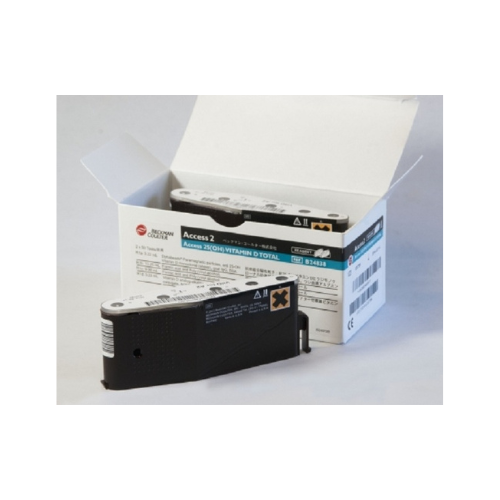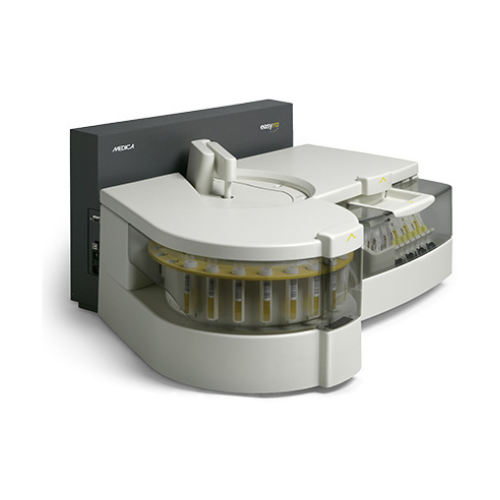For Business Use Only. Does Not Ship to Residential Addresses. For use inside an Analyzer, Sold Separately.
B24838 - Beckman Access 25(OH) Vitamin D Reagent, 100 Determinations, 2 x 50 Tests
Product Code: B24838
Manufacturer: Beckman Coulter
Shipping Weight: 10.00lbs (4.54kg)
Specifications
Brand: Access® 25-OH
Manufacturer: Beckman Coulter
Country of Origin: United States
Application: Reagent
Container Type: Reagent Pack
For Use With: For use with Access 2 Immunoassay System
Number of Tests: 2 X 50 Tests
Sample Type: Serum / Plasma Sample
Test Method: Chemiluminescent Immunoassay
Test Name: 25-hydroxyvitamin D (Vitamin D)
Test Type: Immunoassay / Nutritional Assessment
Intended Use
The Access 25(OH) Vitamin D Total assay is a paramagnetic particle, chemiluminescent immunoassay for the quantitative determination of total 25-hydroxyvitamin D [25(OH) vitamin D] levels in human serum and plasma using the Access 2 Immunoassay Systems. Results are to be used as an aid in the assessment of vitamin D sufficiency.
Summary and Explanation
Vitamin D is a lipid-soluble steroid hormone that is produced in the skin through the action of sunlight or is obtained from dietary sources.
The role of vitamin D in maintaining homeostasis of calcium and phosphorus is well established. Chronic severe vitamin D deficiency in infants and children causes bone deformation commonly known as rickets, while in adults, proximal muscle weakness, bone pain and osteomalacia may develop. Less severe vitamin D inadequacy may lead to secondary hyperparathyroidism, increased bone turnover, and progressive bone loss, increasing the risk of osteoporosis. The presence of the vitamin D receptor in other tissues and organs suggests that vitamin D may also be important in non-skeletal biological processes. Recent studies have associated vitamin D deficiency with increased risk for cancer, autoimmune disease, infectious disease, cardiovascular disease, and many chronic diseases.
Vitamin D exists in two primary forms, vitamin D3 (cholecalciferol), which is produced from the conversion of 7-dehydrocholesterol in the epidermis and dermis in humans upon exposure to sunlight, and vitamin D2 (ergocalciferol) which is acquired in the diet, primarily from oil-rich fish (e.g. salmon, mackerel, and herring), mushrooms, egg yolks, and from foods supplemented with vitamin D. Prescription or over-the-counter dietary supplements are also a major source of vitamin D for many people. Factors such as latitude, time of the day, aging, increased skin pigmentation, ethnic origin, application of sunscreen and season of the year can dramatically affect the production of vitamin D3 in the skin and thus the levels of vitamin D in the blood.
Vitamin D originating from the skin or the diet is biologically inactive. It enters the circulation bound to vitamin D binding protein (DBP), and is transported to the liver to undergo a hydroxylation to produce 25(OH) vitamin D. 25(OH) vitamin D also circulates as a complex with DBP. It is further metabolized in the kidneys by the enzyme 25-hydroxy vitamin D-1α-hydroxylase to its biologically active form, 1,25-dihydroxyvitamin D. 1,25-dihydroxyvitamin D circulates at levels 1,000 times lower than 25(OH) vitamin D and its renal production is tightly regulated by plasma parathyroid hormone levels and serum calcium and phosphorus levels. Serum 25(OH) vitamin D is the major circulating metabolite of vitamin D in the body and reflects vitamin D inputs from cutaneous synthesis and dietary intake. For this reason, serum concentration of 25(OH) vitamin D is considered the standard clinical measure of vitamin D status. Because serum 25(OH) vitamin D will be a mixture of the D2 and D3 forms, both the vitamin D2 and vitamin D3 forms of vitamin D must be measured to accurately assess total 25(OH) vitamin D levels.











